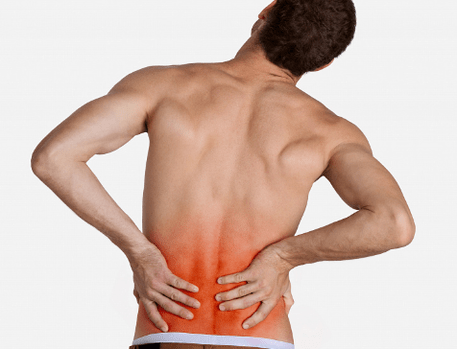The osteochondrosis lumbar is a deformation of the spine in the lumbar spine.The disease influences intervertebral discs, cartilage tissue, spine root and nerve fibers and causes back pain.
Reasons

The main cause of the disease is the improper distribution of the stress on the musculoskeletal system.Usually this happens when walking in high heels, when wearing a bag on one side, with an unpleasant pose in a dream or in a seat.Older people, pregnant, are just born, professional athletes and office workers.
Other causes of lumbar osteochondrosis:
- Injuries, bruises, broken weapons, legs, spine;
- Damage to the organs of the musculoskeletal system;
- Gastrointestinal diseases that cause a lack of beneficial substances;
- Body tension with longer loads;
- Psychoemotional disorders;
- Violations of blood flow in the spine;
- Inflammation of the musculoskeletal system;
- Infections of internal organs and swirls;
- Stiffness of the joints, displacement of slices;
- Hernia's lead and intermediate writing;
- severe poisoning;
- Metabolic disorders;
- Craumatic of the attitude;
- sitting lifestyle;
- Dehydration;
- unbalanced nutrition;
- Calcium and oxygen deficiency;
- Obesity;
- bad habits;
- Age -related changes;
- common illnesses.
Symptoms of lumbar osteochondrosis
The intensity and type of symptoms depend on the stage of the disease.The faster the patient finds signs of lumbosacral osteochondrosis, the more effective the treatment becomes.
General symptoms:
- Severe pain on the back of the back, which can give the feet, inner organs of the abdomen and pelvis;
- Pain in the kidney and the sacrum;
- Fatigue and stress in the lower back and sacred section of the spine;
- Difficulties in moving, walking, tendencies and body applications;
- Periodic background in the back;
- Fatigue according to minor load;
- Crunch in the back, violation of mobility, pain in a quiet condition;
- Dustiness of the limbs;
- Cramps and cramps in the muscles;
- Dizziness;
- Weakness and loss of strength;
- Reduce muscle tone and sensitivity.
Manifestations of lumbar osteochondrosis can vary in men and women.Men can have problems with potency.Women often suffer from pain in the pelvis.If a deformed spine cannot fully support the back, the uterus and attachments experience additional loads and sometimes move over a normal physiological position.
Varieties
The classification of osteochondrosis of the lumbar spine consists of several types of illness.Due to the type of pain syndrome, they differentiate:
lumbago.Acute symptom.It is expressed by sharp bastards and the inability to move.It occurs with muscle cramps, injuries, disks and nerve roots.
Lumbargia.It is characterized by long -term painful pain caused by hernia, forefrises, spondyl arthrodes, ligaments and other diseases of the musculoskeletal system.
sciatica.Powerful pain syndrome in the lumbosacral department, Eradiri in the pool.The pain applies to the sciatic nerve, prevents the normal bending and expansion of the body, prevents me from sitting and standing painlessly.
Disogenic lumbar osteochondrosis and radiculopathy are also distinguished.
Disk lumbar osteochondrosisIt is accompanied by a loss of sensitivity and deafness not only the back of pain, but also the legs, buttocks, the hips and the soil of the abdomen.Sometimes body temperature, weakness, urinary incontinence, the patient loses weight.
RadiculopathyExpressed by numbness of nerve roots and a decrease in human motor skills.Signs - tingling or pain of the entire lower body, impaired reflexes, acceptance of the muscle tone and the limb compounds.
Development stages of lumbar osteochondrosis
Doctors pursue the dynamics of the pathology in four phases:
- First.The symptoms are almost invisible - they are diagnosed in an X rays.The stage begins with pathological processes in the deliberate hollowness of the overdraft panel and the microreter of the fibrous ring.
- The second.The height of the intervertebral discs is reduced, making the vertebrae closely located.This causes gliding and shifting the vertebrae, which are accompanied by pain during the movements.
- The third.It is characterized by stiffness, instability, deafness of the body in the Kokcyx, in the lower back and in the sacrum.This can be explained by the protruding vertebrae, predeters, common transfers and osteoarthritis in the spine.
- Fourth.The hardest degree.The functions of the spine are impaired on them and bone growth (osteophytes) are formed.Growth can pinch the nerves or damage the integrity of the vertebrae.
The consequences of the osteochondrosis of the lumbar spine
- Excessive accumulation of salt in the body;
- Development of hernia, lead, prolapse of the vertebrae and disks;
- Chronic radiculitis;
- Parese and paralysis of the legs.
Diagnosis
The lumbar osteochondrosis and other diseases of the musculoskeletal system can diagnose orthopedists, osteopaths, neurologists, rheumatologists, manual therapists and surgeons.It is possible to diagnose according to:
- X rays of the spine, which shows the condition of bone, cartilage and muscle tissue as well as ligaments and tendons.
- Myelography - studies on cerebrospinal fluid with dye.With their help, the nerve roots of the spinal cord are examined and evaluated.
Doctors use CT and MRI for a more detailed examination.You can diagnose yourself in the clinic.



























